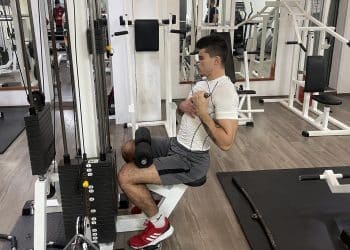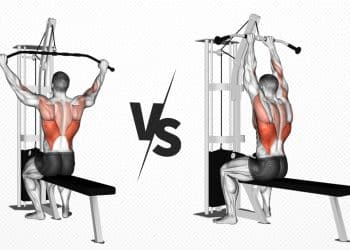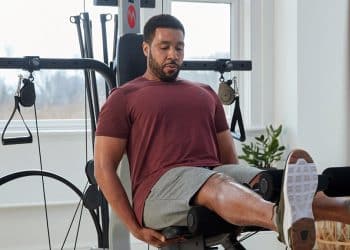Bodybuilders are constantly on the hunt to find the most productive training methods possible. They’ll do almost anything to make an exercise more effective. Small foot or hand position adjustments are often suggested because they MIGHT make a movement more productive, e.g., turning your thumbs downward during lateral raises to maximize medial delt engagement.
While this kind of detail-orientated approach to training could be the difference between first and second place in the Mr. Olympia, it probably won’t matter all that much to the average gym bro who is still a long way from reaching their genetic potential.
Omni grip lat pulldowns are another trick designed to maximize your muscle-building progress. With omni grip lat pulldowns, you do three back-to-back sets of pulldowns using a different grip each time. This ensures you hit more muscle fibers and reach a deeper level of fatigue.
While this is not a new training approach (it’s basically a type of triset or a mechanical advantage drop set), it could help you back more beef on your back.
In this guide, we explain why and how to do omni grip lat pulldowns and provide you with a couple of alternatives.
Omni Grip Lat Pulldowns – Muscles Worked
Omni grip lat pulldowns are a compound or multi-joint exercise. As such, they involve several muscles working together.
Level Up Your Fitness: Join our 💪 strong community in Fitness Volt Newsletter. Get daily inspiration, expert-backed workouts, nutrition tips, the latest in strength sports, and the support you need to reach your goals. Subscribe for free!
The main muscles trained during omni grip lat pulldowns are:
Latissimus dorsi
Known as the lats for short, this is the broad wing-like muscle located on the sides of your upper back. The lats are responsible for the adduction and extension of the shoulder joint and also play a part in shoulder medial rotation. The lats are the target muscle of omni grip lat pulldowns.
Trapezius
The trapezius or traps is the large diamond-shaped muscle that covers much of your upper back. There are three sets of fibers in the traps, each of which has a different function.
The upper traps elevate your shoulder girdle, while the middle traps pull your shoulders backward in a movement called retraction. Finally, the lower traps pull your shoulder girdle downward, which is called depression. The middle and lower traps are most active during omni lat pulldowns.
Rhomboids
The rhomboids work with the middle trapezius to pull your shoulders back and together. These small muscles are located between your shoulder blades and attach them to your thoracic spine. The rhomboids are very important for posture.
Deltoids
The deltoids are your most prominent shoulder muscles. Like the traps, three sets of fibers make up the deltoids, which are commonly referred to as heads – anterior (front), medial (middle), and posterior (rear). Of these three, the posterior deltoids are most active during omni grip lat pulldowns. The medial and anterior heads mainly work as stabilizers and synergists.
Biceps
Located on the front of your upper arm, the biceps flex your elbows and supinate your forearms. The biceps are mostly a synergist during omni grip lat pulldowns, but they’ll still get a good workout from this exercise. In fact, you may feel your biceps working harder than your lats, as they’ll probably start to fatigue first. Using an underhand grip last during omni grip lat pulldowns means your biceps finish up in their strongest position, allowing you to crank out a few more reps.
Forearms
You can’t do omni grip lat pulldowns without keeping a firm grip on the bar, which means your forearms have an important part to play in this exercise. In fact, your forearms may fail before your back and biceps if your gripping muscles are weak. Expect to get a great forearm pump from omni grip lat pulldowns.
How to Do Omni Grip Lat Pulldowns
Get more from omni grip lat pulldowns while keeping your risk of injury to a minimum by following these guidelines:
- Attach a long bar to a lat pulldown machine. Adjust the leg pad, so it fits snugly over your thighs. Select your weight – use something you can lift 8-12 times.
- Hold the bar with a wide, overhand grip. Your hands should be about one and a half shoulder widths apart.
- Sit on the machine with your feet planted firmly on the floor. Lift your chest, pull your shoulders down and back, and lean back slightly. Brace your core.
- Leading with your elbows, bend your arms and pull the bar down to your upper chest. Keep your wrists straight.
- Extend your arms and repeat to within a couple of reps of failure.
- Next, stand up and move your hands into a medium or shoulder-width grip. Sit back down and crank out roughly the same number of reps.
- Stand up one more time and move your hands to a narrow underhand grip. Sit down and pump out your final set of reps.
Tips:
- Use lifting straps or gym chalk if your grip fails before your lats.
- Always start with your weakest hand position, and finish with your strongest.
- Use less weight/do fewer reps than you expect – this exercise is TOUGH!
- It’s okay to reduce the weight from exercise to exercise if your muscles fatigue quickly.
- Omni grip lat pulldowns are very demanding, and 2-3 sets should be sufficient. Doing more could result in overtraining.
- You can also do medium, narrow, underhand omni grip lat pulldowns or wide, narrow, underhand. Providing you move from a hard to an easier variation, they will work.
Omni Grip Lat Pulldowns Benefits and Drawbacks
Not sure if omni grip lat pulldowns deserve a place in your back workouts? Consider these benefits and then decide!
Hit your lats from multiple angles
Bodybuilders perform multiple exercises per body part to develop it fully. Training angles matter! Omni grip lat pulldowns allow you to hit your back with a wide, narrow, and underhand grip, giving you a better opportunity to train all the available muscle fibers.
Increased training volume
While you should move quickly between different positions, you’ll still get 5-10 seconds between wide, medium, and underhand grips. These brief rests will allow you to crank out more reps than usual.
So, where you usually do 8-12 reps of regular lat pulldowns, you will probably double or even triple that number, which should shock your muscles into a new growth spurt.
Increased training intensity
Omni grip lat pulldowns involve training close to failure not once but three times in quick succession. And like the increase in volume, this rise in intensity should trigger renewed muscle growth.
A tremendous muscle pump
Doing lots of reps with a moderately heavy load should drive a lot of blood into your lats and biceps, producing a skin-splitting pump. Bodybuilders have long believed getting a good pump is critical for muscle growth. If nothing else, it drives oxygen and nutrients into your muscles to facilitate recovery.
Novelty effect
If you have never done omni grip lat pulldowns before, your muscles are in for a shock! Doing the same workout or exercises over and over can lead to a training plateau. Omni grip lat pulldowns are uniquely challenging and could help blast you out of your current lat training rut.
While omni grip lat pulldowns are a mostly beneficial exercise, there are also a few drawbacks to consider:
Reduced weight = less strength
Doing what amounts to three back-to-back sets of lat pulldowns means you’ll have to use a little less weight than usual, which will compromise your strength gains. However, if you are training for hypertrophy and don’t care about strength, this is probably not an issue.
You’ll soon adapt to doing them
Initially, omni grip lat pulldowns will feel incredibly challenging and provide your muscles with a novel stimulus, triggering new muscle growth. However, if you do them for a few weeks, your body will soon adapt, and they will no longer be so stimulating. Like all ultra-intense training methods, omni grip lat pulldowns are not usually suitable for long-term use.
Low-quality reps, especially toward the end of your set
While you should have no problem performing your early reps with good form, as fatigue sets in, your technique will probably break down as you try to pump out your remaining reps.
You can avoid this problem by using a lighter weight, but that could make the early reps too easy. Alternatively, you could do fewer reps with your second and third grip choices or reduce the weight.
Trying to do the same number of reps with the same weight on all three grips will invariably lead to technical faults. This could make your workout less effective or cause elbow or shoulder injuries.
Omni Grip Lat Pulldown Alternatives
Omni grip lat pulldowns are a decent back exercise, but that doesn’t mean you need to do them all the time. There are a few variations and alternatives you can use to keep your workouts productive and interesting:
Level Up Your Fitness: Join our 💪 strong community in Fitness Volt Newsletter. Get daily inspiration, expert-backed workouts, nutrition tips, the latest in strength sports, and the support you need to reach your goals. Subscribe for free!
1. Mechanical advantage drop set pull-ups
No lat pulldown machine? No problem! You can achieve a similar training effect by moving from a weak to a strong pull-up grip. This is a mechanical advantage drop set and one of the most effective but challenging ways to bust through your pull-up plateau and master this classic bodyweight exercise once and for all.
Steps:
- Hold your pull-up bar with an overhand, slightly wider than shoulder-width grip, and hang with your arms straight and feet off the floor. Pull your shoulders down and back, and brace your core.
- Bend your arms and pull your chin up to the bar.
- Lower yourself down and repeat to within 1-2 reps of failure.
- Rest 10 seconds, switch to an underhand grip, and continue to within 1-2 reps of failure.
- Rest a final 10 seconds, adopt a neutral grip, and rep out to failure one more time.
- Rest for 2-3 minutes, and then repeat the entire three-move sequence again.
Muscles Targeted:
Primary: Latissimus dorsi, biceps.
Secondary: Trapezius, rhomboids.
Benefits:
- A home workout alternative to omni lat pulldowns.
- A great way to increase your pull-up performance.
- Build bigger arms and lats simultaneously.
- Suitable for advanced exercisers.
Tips:
- You can do this exercise with body weight only or weighted as preferred.
- Use a resistance band or assisted pull-up machine to make this exercise easier.
- Use negative reps to push your muscles beyond failure.
2. Omni grip T-bar rows
Most T-bar row machines have multiple handles, which makes them perfect for omni-grip training. We’ll be honest; we’ve just invented this exercise, but someone had to be the first to do omni grip lat pulldowns, so it’s all good, bro!
Steps:
- Stand astride the bar and hold the handle using a wide, overhand grip.
- Lift the weight, hinge forward from the hips, and lower your upper body down until it’s roughly parallel to the floor. Brace your core, and pull your shoulders down and back.
- Bend your arms and pull the bar up to your chest. Lead with your elbows, and keep your wrists straight. Continue to within a couple of reps of failure.
- Put the weight down, switch to a medium grip and then rep out again.
- Set the weight down again, adopt a parallel or underhand grip, and do your final reps. Take care not to let your lower back round.
- Rest for a couple of minutes, and then repeat the entire three-move sequence again.
Muscles Targeted:
Primary: Latissimus dorsi, biceps.
Secondary: Trapezius, rhomboids, core, erector spinae.
Benefits:
- Another way to perform multi-grip omni training.
- Hit your lats from an entirely different angle, i.e., horizontally instead of vertically.
- An excellent way to make the most of the different handles on the T-bar row machine
Tips:
- Use a chest-supported T-bar row, if available, to take stress off your lower back.
- Use straps or chalk to reinforce your grip.
- Wear a weightlifting belt to support and protect your lower back.
3. Omni grip seated row
If you can do omni grip lat pulldowns, you can apply the same training method to seated rows. Just make sure you maintain good posture throughout and avoid using your lower back to help you lift the weights. This exercise needs to be done with clean form, or injury could be the result.
Steps:
- Attach a long bar to a seated row machine. Sit on the bench with your legs extended but not straight.
- Hold the bar with a wide, overhand grip. Your hands should be about one and a half shoulder widths apart.
- Sit up straight, lift your chest, pull your shoulders down and back, and brace your core.
- Leading with your elbows, bend your arms and pull the bar into your abdomen. Keep your wrists straight. Extend your arms and repeat to within a couple of reps of failure.
- Next, move your hands into a medium or shoulder-width grip and crank roughly the same number of reps.
- Finally, move your hands to a narrow underhand grip and pump out your final set of reps.
- Rest for 2-3 minutes, and then repeat the entire three-move sequence again.
Muscles Targeted:
- Primary: Latissimus dorsi, biceps.
- Secondary: Trapezius, rhomboids, core, erector spinae.
Benefits:
- A useful exercise for building back thickness.
- An excellent alternative to straight sets and regular seated rows.
- A challenging exercise for advanced lifters.
Tips:
- Use lifting straps or chalk to secure your grip.
- Take care not to round your lower back at any point, as doing so could cause serious injury.
- Focus on leading with your elbows, keeping your wrists straight, and pulling your shoulders down and back to maximize the effectiveness of this exercise.
Omni Grip Lat Pulldown FAQs
Do you have a question about Omni grip lat pulldowns or back training in general? That’s okay because here come the answers!
1. Are omni grip lat pulldowns safe?
Omni grip lat pulldowns are no riskier than regular pulldowns. The only difference between this exercise and the conventional way of doing pulldowns is that you switch hand positions from wide to medium to narrow. There is no reason to think that this would increase your risk of injury.
However, because fatigue levels will probably be quite high, there is a chance that your form may deteriorate to such a degree that you perform the exercise incorrectly, e.g., lean back too much or jerk the weight down. Poor form could potentially lead to elbow, shoulder, or lower back problems.
So, make sure you do all the parts of omni grip lat pulldowns correctly, and you will have nothing to worry about.
2. Will omni grip lat pulldowns build muscle?
Despite taking you outside the standard 6-12 rep range, omni grip lat pulldowns should build muscle. They a) generate plenty of muscle tension, b) create a lot of metabolic stress, and c) take your muscles within a couple of reps of failure. These are the three “ingredients” of successful hypertrophy training.
3. Does it matter which grip I use first with omni grip lat pulldowns?
It certainly does!
You should always start with your weakest grip and finish with your strongest. This usually means moving from a wide hand position to a narrow one. Leaving the strong grip for last means that you have the best chance of completing plenty of reps.
If you leave your weakest position to the end, you may find yourself unable to perform many (or any!) reps.
4. Can I use different hand positions for omni grip lat pulldowns?
Sure! Just remember to start with your weakest grip and finish with your strongest. For example, you could go medium overhand, narrow overhand, narrow underhand, or wide, neutral, underhand.
There is no “official” omni grip lat pulldown protocol, so feel free to experiment to find what works best for you. Omni simply means all, so use whatever hand positions you want.
5. Are omni grip lat pulldowns all I need to build my back?
Omni grip lat pulldowns are a vertical pulling exercise. Vertical pulls are excellent for building upper back width, but for back thickness, most bodybuilders recommend doing horizontal pulling exercises, i.e., rows.
As such, omni grip pulldowns are only part of the back-building equation. They’re a good exercise, but you need to combine them with a similar volume of rowing, too.
Because of this, the best back workouts usually comprise equal parts vertical and horizontal pulling. In other words, for every pulldown/pull-up, you should also have a rowing movement.
6. How many times a week should I train my back?
Most muscle groups respond best to two workouts per week separated by a couple of days to allow time for rest, recovery, and growth, e.g., Monday and Thursday.
Some lifters prefer to train their muscles once per week, but this invariably means marathon workouts with lots of exercises and sets. Doing two workouts means you can divide your training workload into more manageable sessions and work harder because you are less fatigue.
Conversely, you could train your muscles with a higher frequency, i.e., three times per week, but this may be too much to recover from.
Twice a week seems optimal for most exercisers.
More Lat Pulldowns Exercises:
- Lat Pulldowns Vs. Pull-Ups: Which One Should You Do?
- 9 Best Hammer Strength Lat Pull Alternative Exercises
- 10 Lat Pulldown Alternative Exercises for A HUGE Back
- Push-Pull-Legs Bowflex Workout
- Pronated Pulldown – Muscles Worked, How-To, Benefits, and Alternatives
- What is the Best Chin-up and Pull-up Alternative?
Wrapping Up
There is nothing magical about omni grip lat pulldowns, and the basic concept is nothing new. All you are doing is moving your hands from a weak position to a strong position, so you can extend your set beyond its typical termination point while hitting your back from a couple of different angles.
This type of training has been popular for decades and is known as mechanical advantage drop sets.
New names aside, if your back hypertrophy has stalled and you want to regain your momentum, a few weeks of omni grip lat pulldowns could help get you back on track.
However, this training method is quite intense, so you should use it and not abuse it. Pay attention to rest and recovery to ensure your body has the resources it needs to adapt and grow between workouts. Also, don’t add it to all your back workouts, or use it indefinitely. Use omni grip lat pulldowns to shock and awe your muscles into growing again.
Finally, remember that you can apply omni-grip training to a host of different exercises. Just make sure you start with the most challenging exercise variation and finish with the easiest.
Interested in measuring your progress? Check out our strength standards for Pull Ups, T Bar Row, Clean, and more.









